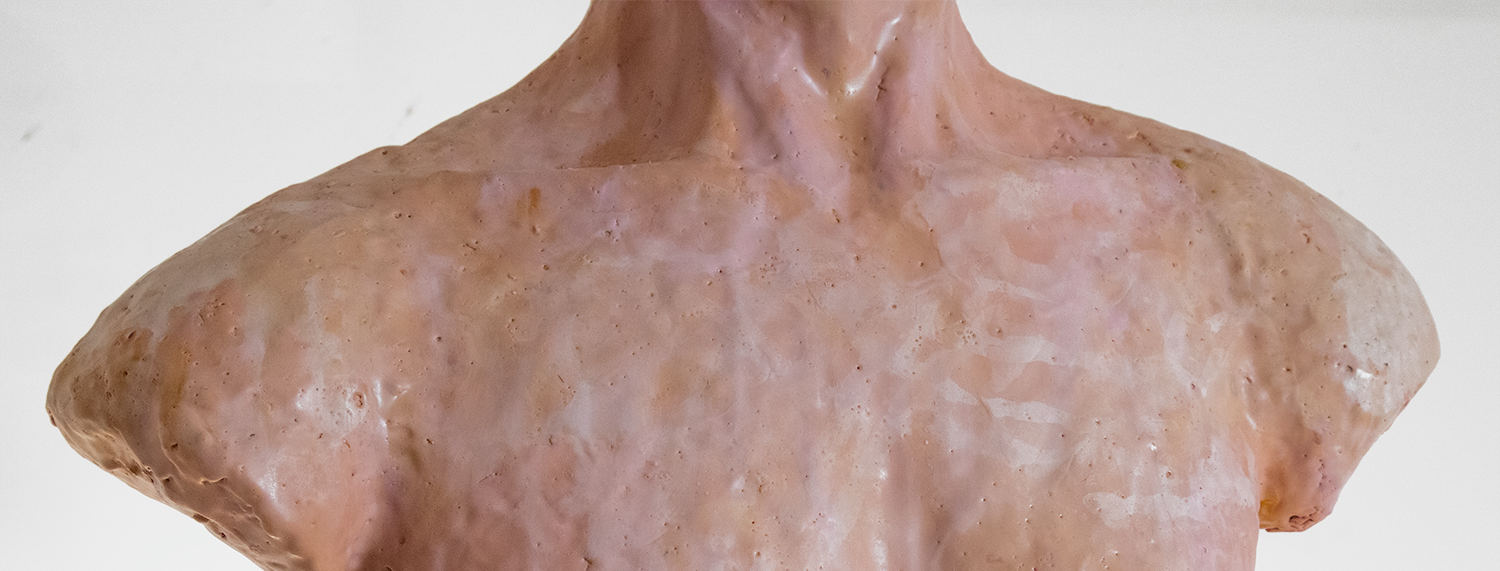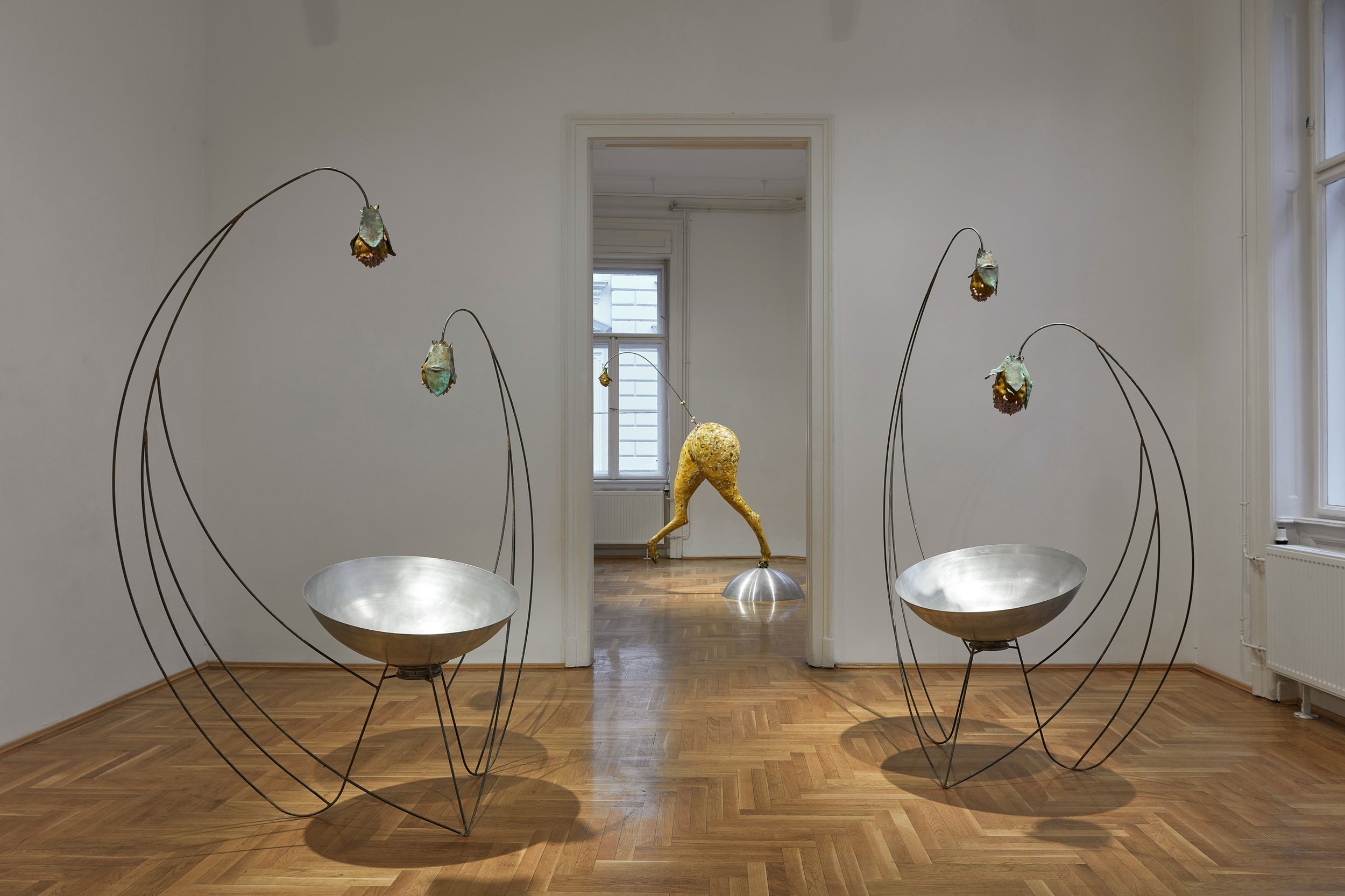Gideon Horváth: Myths of Vulnerability / A sebezhetőség mítoszai
önálló kiállítás | solo exhibition
bronz és méhviasz szobrok | sculptures, bronze and beeswax
2023. 02. 24 – 04. 14.
Megnyitó | Opening: 2023. 02. 24. Friday
at 6 pm.
Myths of Vulnerability[1] / A sebezhetőség mítoszai
sculptures, bronze and beeswax / szobrok, bronz és méhviasz
‘That’s your speciality, telling people stories they never imagined – and convincing them it’s reasonable to want to see them come true’ – writes feminist activist writer and filmmaker Virginie Despentes in the foreword to An Apartment on Uranus[2].
The book is a collection of newspaper columns by queer theorist Paul B. Preciado, published in the French daily Libération from 2013 to 2018, which discusses the author's transition in the context of current social, cultural and political-activist issues and events.
He begins his treatise on the emancipation of non-binary / queer existence with the metaphor of the farthest planet and the ancient Greek god. Uranus is the "frozen giant", the coldest planet in the solar system. In Greek mythology, the god of the sky, husband of Gaia/Mother Earth, representative of the first, primordial generation of gods, father of the Titans, including Cronus and the Cyclops. Born from her castration, Aphrodite Urania, the goddess of male love, considered superior, and spoken of by Pausanias in The Banquet, in Plato’s dialogue, distinguishing this celestial phenomenon from terrestrial, mainly heterosexual love. Karl Heinrich Ulrich, a German gay rights activist who fought for the rights of the ‘third sex’ and ‘other lovers’, proposed the term ‘Urning’ (Uranism) in 1864 to describe attraction between men.
Gideon Horváth's installation in a former bourgeois apartment, appearing as a dream-like vision, is inspired in part by this ‘Uranian journey’, by the personal and collective narratives of fluid-queer existence, and by the experience of emotional and physical exposure. The interconnected sculpture-object assemblages of the four spaces thematize the visceral experience of vulnerability, one of the most complex of basic human conditions. Horváth thinks of vulnerability not as a passive state of suffering, but as a liberating form of action, a possible form of resistance. A condition in which the repressed, ambivalent, in-between, liminal knowledge and positions can be revealed.
In the present social context, the body, but especially the body excluded by patriarchal norms, is rarely seen outside the political context. Horváth radicalizes vulnerability through intimacy. For the first time, he uses the fragile, easily malleable yet resilient and enduring beeswax in coloured form and combines it with his distinctive bronze-cast, delicately patinated plant motifs. The fragmented and diffuse forms, drawing on mythological, natural and anatomical allusions: the almost life-size body of a horse, reminiscent of a running centaur, the overripe fruit-flowers, the organs exploding from a fictitious body part, all forming an organic collage. The exhibition ends with an androgynous bust in the final space, born from a reinterpretation of the classical bust format: an ‘anatomical’ portrait of Uranus, modelling the permeability of gender and sexuality, and the possibilities of freedom to exist in fluid bodies.
Lívia Páldi
[1] Paul B. Preciado, An Apartment on Uranus. Fitzcarraldo Press, London, 2019. Translation: Charlotte Mandel.
[2] The American writer and social worker Brené Brown has been researching the phenomena of courage, vulnerability, shame and compassion for more than a decade and a half. Her book Daring Greatly (2015) was an important inspiration for the exhibition. Another important reference is the volume Vulnerability in Resistance, Judith Butler, Zeynep Gambetti & Leticia Sabsay (eds.), Duke University Press, 2016.
„A te erősséged az, hogy olyan történeteket mondasz el az embereknek, amiket addig el sem tudtak képzelni – és meggyőzöd őket arról, hogy méltányos, ha azt akarják, hogy ezek valóra is váljanak.” – írja a feminista aktivista író, filmrendező Virginie Despentes az An Apartment on Uranus [Lakás az Uránuszon] előszavában.[1]
A kötet a queer teoretikus Paul B. Preciado 2013–2018 között a francia napilapban a Libération-ban megjelent rövid írásainak gyűjteménye, amely a szerző tranzícióját az aktuális társadalmi, politikai-aktivista kulturális kérdések és események kontextusában beszéli el.[2]
A nembináris/queer létezés emancipációjának traktátusát a legtávolabbi bolygó és a görög ősisten metaforájával indítja. Az Uránusz a „megfagyott óriás”, a Naprendszer leghidegebb bolygója. A görög mitológiában az eget megszemélyesítő isten, Gaia-Földanya férje, az első, legősibb istennemzedék képviselője, a titánok, köztük Kronosz és a küklopszok apja. Kasztrációjából születő Aphrodité Uránia, a magasabb rendűnek tartott férfiszerelem istennője, akiről Platón, A lakoma című dialógusában Pauszaniasz beszél, megkülönböztetve ettől az égi jelenségtől a földi, főképp heteroszexuális szerelmet. Karl Heinrich Ulrich a „harmadik nem” és a „másképp szeretők” jogaiért küzdő német melegjogi aktivista 1864-ban javasolta az „Urning” (Uranism) fogalmát, hogy leírja a férfiak közötti vonzódást.
Horváth Gideon az egykori nagypolgári lakásban álomszerű vízióként megjelenő installációját részben ez az „uránuszi utazás”, a fluid-queer létezés személyes és kollektív narratívái, érzelmi és fizikai kitettségének tapasztalata ihlette. A négy tér egymásba kapcsolódó szobor-tárgy együttesei az egyik legösszetettebb emberi alapállapot, a sérülékenység (vulnerability) zsigeri tapasztalatát tematizálják. Horváth a kiszolgáltatottságról nem mint elszenvedett passzív állapotról, hanem mint felszabadító cselekvési formáról, lehetséges ellenállásról gondolkodik. Egy olyan kondícióról, ahol az elnyomott, ambivalens, köztes, liminális tudások és poziciók megmutathatók.
A jelen társadalmi környezetben a testet, de különösen a patriarchális normatívák által kirekesztett testet, ritkán láthatjuk a politikai kontextuson kívül. Horváth a törékenységet az intimitáson keresztül radikalizálja. Most először használja a sérülékeny, könnyen formálható ugyanakkor reziliens és időtálló méhviaszt színezett formában és ötvözi jellegzetes növényi motívumainak bronzba öntött és finoman patinázott példányaival. A mitológiai, természeti és anatómiai idézetekből építkező töredékes és diffúz formák: a futó kentaurt idéző, majdnem életnagyságú lótest, a túlérett gyümölcs-virágok, egy fiktív testegészből kiváló-kirobbanó szervek organikus kollázst alkotnak. A kiállítást a legutolsó térben elhelyezett, a klasszikus mellszobor formátum újragondolásából született androgün büszt zárja: a nemek, a szexualitás átjárhatóságát, a változó testekben való létezés szabadságának lehetőségeit mintázó „anatómiai” Uránusz portréja.
Páldi Lívia
[1] Az amerikai iró, szociális munkás Brené Brown több mint másfél évtizede kutatja a bátorság, a sebezhetőség, a szégyen és az együttérzés jelenségeit. A Bátraké az erő című kötete fontos inspirációt jelentett a kiállításhoz. Fontos referencia a Vulnerability in Resistance, Judith Butler, Zeynep Gambetti & Leticia Sabsay (eds.), Duke University Press, 2016
[2] Paul B. Preciado, An Apartment on Uranus. Fitzcarraldo Press, London, 2019. Translation: Charlotte Mandel. Az idézet: ‘That’s your speciality, telling people stories they never imagined – and convincing them it’s reasonable to want to see them come true’. p. 22.


